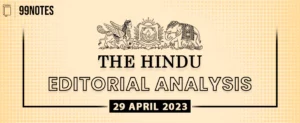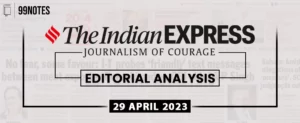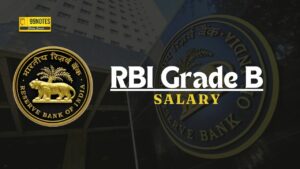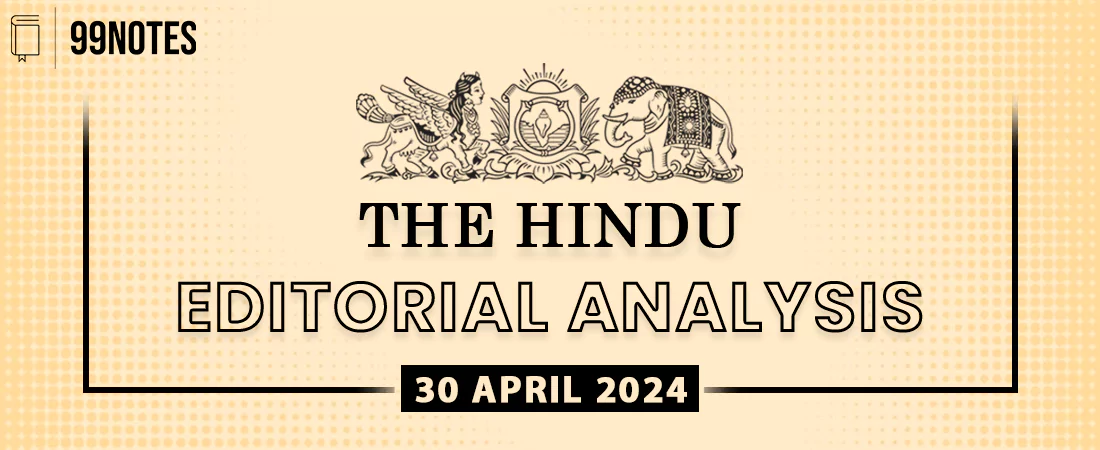30 April 2024 : The Hindu Editorial Notes PDF
The Hindu EDITORIAL
30-April-2024
1. Court’s nudge on hospital charges, a reform opportunity
| Topic: GS2 – Social Justice – Health, GS2 – Polity – Judiciary
The regulation of private hospital procedure rates is crucial for addressing healthcare inefficiencies, a significant topic for UPSC exams. |
| Context: |
| ● The Supreme Court of India directed the government to regulate private hospital procedure rates due to high costs and variations, addressing healthcare inefficiencies. |
Introduction:
- The Supreme Court of India directed the central government to regulate hospital procedure rates in the private sector due to high costs and variations.
- The proposal aims to tackle inefficiencies and inequities in India’s predominantly private healthcare delivery system.
Key Considerations for Regulation:
Benchmark for Pricing:
- In an unregulated market, providers focus on profit, leading to overpricing and overprovision of care.
- “Yardstick competition” faces challenges due to diverse patient profiles and weak regulatory frameworks.
- Standard treatment guidelines (STGs) can establish clinical needs and total input costs, ensuring fair pricing.
Limited Regulatory Capacity:
- Over half of India’s health expenditure is out-of-pocket (OOP), hindering standardization efforts.
- Weak enforcement mechanisms raise doubts about the feasibility of regulating procedure rates.
Weak Implementation:
- Command-and-control regulations like price caps may have temporary effects without strong enforcement mechanisms.
- Only a fraction of states have implemented the Clinical Establishment Act, indicating weak enforcement.
Stakeholders’ Misaligned Incentives:
- Rate standardisation may not address fundamental issues like misaligned incentives among stakeholders.
- Comprehensive health financing reform is necessary to ensure effective regulation.
Limited Data:
- Efforts to develop STGs and costing frameworks face challenges due to limited data, hindering progress.
- Initiatives like the Pradhan Mantri Jan Arogya Yojana aim to address these data limitations.
Opportunities for Effective Regulation:
- The Supreme Court’s directive provides an opportunity to address systemic health system issues.
- Future efforts should focus on feasible, implementable policies that build on existing reforms and ensure stakeholder participation.
Conclusion:
- Addressing the challenges of regulating hospital procedure rates in India requires a comprehensive approach that considers pricing benchmarks, regulatory capacity, implementation mechanisms, stakeholder incentives, and data availability.
| High Health Out-Of-Pocket (OOP) Expenditure In India |
| Some important facts:
● Government health expenditure in India was 28.6% of total health expenditure in 2013-14, increasing to 40.6% by 2022-23. ● Out-of-pocket expenditure decreased from 64.2% in 2013-14 to 48.2% in 2022-23, which is still high compared to develop countries. ● Per capita health expenditure amounted to ₹4,470. ● Uttar Pradesh had notably high out-of-pocket estimates, reaching 71.3%. Reasons for High Health Out-Of-Pocket (OOP) Expenditure: ● Inadequate Health Insurance Coverage: Limited coverage under public and private health insurance schemes results in a higher burden of healthcare costs borne by individuals and families. ● Underfunded Public Healthcare System: Insufficient government spending on healthcare infrastructure, facilities, and services leads to a reliance on private healthcare providers, resulting in higher out-of-pocket expenses. ● High Cost of Medication and Treatment: Expensive medical procedures, diagnostic tests, and medications contribute to the overall healthcare expenditure, especially for chronic diseases and specialized treatments. ● Lack of Preventive Healthcare Services: Inadequate emphasis on preventive healthcare measures and primary healthcare services results in higher healthcare costs due to the treatment of preventable diseases at advanced stages. ● Geographical Disparities: Unequal distribution of healthcare facilities and providers across regions leads to increased travel and accommodation expenses for accessing healthcare services, adding to out-of-pocket expenditure. Implications of High Health Out-Of-Pocket (OOP) Expenditure: ● Financial Hardship: Excessive healthcare spending leads to financial strain on individuals and households, pushing them into poverty or debt. ● Healthcare Access Barriers: High out-of-pocket expenses deter individuals from seeking timely medical care, resulting in delayed treatment and adverse health outcomes. ● Inequitable Healthcare Access: Affordability issues exacerbate healthcare disparities, with marginalized and low-income populations facing barriers to accessing quality healthcare services. ● Economic Burden: High out-of-pocket expenditure on healthcare hampers economic growth and development by reducing disposable income and consumption expenditure. ● Healthcare Quality Compromise: Cost considerations may lead individuals to opt for lower-quality or unregulated healthcare services, compromising their health outcomes and safety. Way Forward to Reduce Health Out-Of-Pocket (OOP) Expenditure: ● Strengthening Public Healthcare: Increase government investment in public healthcare infrastructure, facilities, and services to reduce dependence on expensive private healthcare. ● Expanding Health Insurance Coverage: Enhance the coverage and benefits of public health insurance schemes to reduce the financial burden on individuals and families. ● Promoting Preventive Healthcare: Focus on preventive healthcare interventions and primary healthcare services to reduce the incidence of costly diseases and hospitalizations. ● Regulating Healthcare Costs: Implement price controls and regulations on healthcare services, medications, and medical devices to make them more affordable and accessible. ● Encouraging Generic Medicines: Promote the use of generic medications and generic drug substitution to lower medication costs and reduce out-of-pocket expenses for patients. ● Community Health Financing: Explore community-based health financing models such as health cooperatives and microinsurance schemes to pool resources and spread the financial risk of healthcare expenses. ● Improving Healthcare Efficiency: Enhance healthcare delivery efficiency through technology adoption, telemedicine, and streamlining administrative processes to reduce healthcare costs and improve affordability. |
| PYQ:
Q.1 Appropriate local community-level healthcare intervention is a prerequisite to achieve ‘Health for All ‘ in India. Explain. (150 words/10m) (UPSC CSE (M) GS-2 2018) Q.2 Public health system has limitations in providing universal health coverage. Do you think that the private sector could help in bridging the gap? What other viable alternatives would you suggest? (200 words/12.5m) (UPSC CSE (M) GS-2 2015) |
| Practice Question: Discuss the significance of regulating private hospital procedure rates in India and analyse the challenges associated with its implementation. (250 Words /15 marks) |
2. The poultry industry needs urgent reforms
| Topic: GS2 – Social Justice – Health, GS3 – Indian Economy
Understanding biosecurity risks in the poultry industry is vital for public health, environmental conservation, and animal welfare, relevant to UPSC. |
| Context: |
| ● The news highlights the biosecurity risks and animal welfare concerns in India’s poultry industry amidst the H5N1 outbreak and calls for legal reforms to address these issues. |
Scale of the biosecurity issue in poultry industry:
- H5N1, originating from chickens in Hong Kong in 1997, led to the first human infection in India in 2006.
- December 2020 and early 2021 saw outbreaks across 15 Indian States.
- WHO estimates a 52% fatality rate for H5N1 since 2003.
- The virus has affected diverse species, including polar bears, seals, and seagulls.
- Contaminated environments in poultry farms contribute to the spread of the virus.
Challenges in poultry farming:
- Poultry units with over 5,000 birds are classified as polluting industries by the CPCB.
- Farmers struggle due to market volatility and industry practices, like excessive antibiotic use.
- Antibiotics classified as critically important by WHO are used prophylactically in poultry.
- Intensive confinement and poor living conditions violate the PCA Act, causing suffering to animals.
Path to legal reform:
- The 2017 Law Commission Report highlighted antibiotic resistance due to unhygienic conditions in poultry farms.
- Draft rules for chicken welfare released in 2019 by the Ministry of Agriculture are criticized as weak.
- Recommendations include improved animal welfare, waste management, and antibiotic use based on international best practices.
- Strict oversight and enforcement of environmental regulations are crucial, given the poultry industry’s reclassification as highly polluting.
| Antibiotic Resistance |
| What is antibiotic resistance ?:
● Definition: Antibiotic resistance occurs when bacteria evolve and become resistant to the antibiotics designed to kill them, rendering the medications ineffective. ● Mechanism: Bacteria can develop resistance through genetic mutations or by acquiring resistance genes from other bacteria. Implications of Antibiotic Resistance: ● Limited Treatment Options: Reduced effectiveness of antibiotics leads to limited treatment options for bacterial infections, increasing the risk of treatment failure and adverse health outcomes. ● Prolonged Illness: Antibiotic-resistant infections may result in prolonged illness, hospitalisation, and complications, posing significant challenges for patient recovery and healthcare management. ● Increased Mortality: Higher mortality rates are associated with antibiotic-resistant infections due to the difficulty in treating these infections effectively. ● Healthcare Costs: Antibiotic resistance contributes to higher healthcare costs, including increased spending on alternative treatments, longer hospital stays, and management of complications. ● Global Health Threat: Antibiotic resistance is a global health threat that undermines the effectiveness of modern medicine, jeopardising the treatment of infectious diseases and public health interventions. |
| PYQ: Can overuse and the availability of antibiotics without doctor’s prescription, the contributors to the emergence of drug-resistant diseases in India? What are the available mechanisms for monitoring and control? Critically discuss the various issues involved. (200 words/12.5m) (UPSC CSE (M) GS-3 2014) |
| Practice Question: How does the poultry industry’s biosecurity risk impact public health, environmental conservation, and animal welfare? Discuss with relevant examples and policy recommendations. (250 Words /15 marks) |
For Enquiry

30 April 2024 : The Hindu Editorial Notes PDF Copy

30 April 2024 : Indian Express Editorial Analysis

RBI Grade B Salary- In Hand Salary, Grade Pay, Job Profile, Perks & Allowances

29 April 2024 : Daily Current Affairs Quiz

29 April 2024 : Daily Answer Writing

29 April 2024 : PIB Summary for UPSC

29 April 2024 : Daily Current Affairs

29 April 2024 : The Hindu Editorial Notes PDF

29 April 2024 : Indian Express Editorial Analysis

Sub Inspector Salary per month in India- Check other Perks & Allowance also
April 2024 The Hindu Editorial 30 April 2024 : The Hindu Editorial Notes PDF Copy The Hindu EDITORIAL
30-April-2024
1. Court’s nudge on hospital charges, a reform opportunity
Topic:…
April 2024 Indian Express 30 April 2024 : Indian Express Editorial Analysis Indian Express Editorial Analysis
30-April-2024
1. Mind the gap
Topic: GS2 – Governance – Government…
Blogs Upsc RBI Grade B Salary- In Hand Salary, Grade Pay, Job Profile, Perks & Allowances RBI Grade B Salary- The starting salary of an RBI Grade B officer in India ranges from around INR 68,410…
Daily Quiz 29 April 2024 : Daily Current Affairs Quiz 29- April 2024 : Daily Quiz…
mains answer writing 29 April 2024 : Daily Answer Writing Mains Answer Writing
29-April-2024
Q1) Why are TOP (tomato, onion, potato) crops susceptible to large…
April 2024 PIB 29 April 2024 : PIB Summary for UPSC PIB Summary for UPSC
29-April-2024
1. Mines Ministry to Hold Two-day Critical Minerals Summit from Tomorrow
Topic:…
April 2024 Daily Current Affairs 29 April 2024 : Daily Current Affairs Daily Current Affairs
29-April -2024- Top News of the Day
1. India’s imports from China rise to $101…
April 2024 The Hindu Editorial 29 April 2024 : The Hindu Editorial Notes PDF The Hindu EDITORIAL
29-April-2024
1. Inequality can no longer be ignored
Topic: GS2 – Social Justice,…
April 2024 Indian Express 29 April 2024 : Indian Express Editorial Analysis Indian Express Editorial Analysis
29-April-2024
1. FOR FUTURE READY SENIORS
Topic: GS2 – Social Justice…
Blogs Upsc Sub Inspector Salary per month in India- Check other Perks & Allowance also Sub Inspector Salary – The starting salary of a police sub-inspector in India can vary from state…




